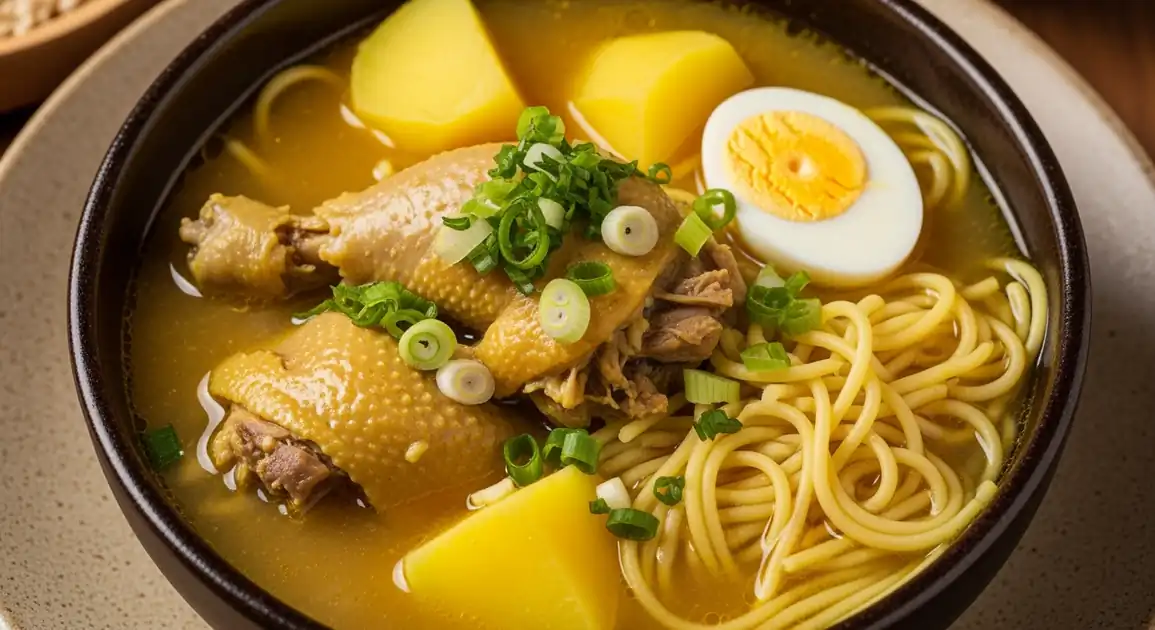Caldo de Gallina (Hen Broth)
Caldo de Gallina

Description
In the high altitude and often chilly climate of Cusco, a steaming bowl of Caldo de Gallina is especially welcome and popular. Find it served fresh and hot in the famous Mercado San Pedro, local 'picanterías', and eateries catering to both locals and tourists seeking warmth and sustenance.
Dietary Information
Serving information
Serving style
Served very hot in deep bowls. Standard toppings (cancha, cebolla china, ají, lime) are usually provided on the side.
Quick facts
Market stalls typically from early morning (around 6 AM/7 AM) until mid-afternoon (3 PM/4 PM). Restaurants follow standard lunch and dinner hours.
Safety Tips
What to Look For
-
Soup served steaming hot
Ensures the soup is at a safe temperature (above 60°C / 140°F), minimizing bacterial risk. Visible steam is a good sign.
-
Busy vendor with high turnover
Indicates the soup is frequently replenished and likely kept consistently hot. Popular stalls often maintain quality.
-
Clean serving area, bowls, and utensils
Basic hygiene is crucial. Look for clean ladles, bowls washed properly, and vendors handling food cleanly.
-
Fresh-looking toppings
Garnishes like scallions should look fresh and green, not wilted. Cancha should be crisp.
-
Clear, rich broth (not murky or separated weirdly)
While rich yellow, the broth should look appetizing and well-emulsified, not like old soup with odd textures.
What to avoid
-
Soup that is lukewarm or cold
This is the danger zone for bacterial growth. Never consume lukewarm Caldo de Gallina.
-
Dirty stall, visibly unclean bowls or utensils
Increases the risk of contamination significantly.
-
Pre-cooked ingredients (potato, egg, noodles) sitting out uncovered for long periods
These should be added fresh or kept properly heated/chilled and covered.
-
Vendors with poor personal hygiene (dirty hands)
Direct handling of food requires clean hands or utensils.
-
Soup with an 'off' smell or taste
Trust your senses. If it smells sour (beyond lime addition) or unpleasant, do not eat it.
Price information
Price range
Budget tips
- Mercado San Pedro offers authentic and affordable bowls (10-18 PEN).
- Small local eateries outside the main tourist square are cheaper.
- Restaurants near Plaza de Armas will charge more (15-25 PEN).
- It's generally a filling and budget-friendly meal.
Value indicators
- Served steaming hot – crucial in Cusco's climate.
- Rich, flavourful broth that warms you up.
- Tender meat and perfectly cooked potato/noodles.
- Generous portion size.
Where to Find This Dish
Mercado San Pedro
The central market has a well-known food section with several stalls specializing in Caldo de Gallina and other soups.
Main entrance, Designated soup/food stall area
Morning, Lunch
Streets around Mercado San Pedro
Smaller eateries and stalls often set up near the market.
Tullumayo Avenue, Cascaparo Street
Morning, Lunch
Local Picanterías / Restaurants
Traditional restaurants slightly away from the main tourist center offer authentic versions.
San Blas neighbourhood (check specific restaurants), Avenida Garcilaso
Lunch, Dinner
Vendor Tips
- In Mercado San Pedro, observe which stalls are busiest with locals.
- Don't be afraid to sit at the communal benches in the market stalls.
- Ask for 'Caldo de Gallina', not just 'Caldo de Pollo', for the authentic rich version.
- Be prepared for simple, no-frills settings in market stalls and local eateries.
How to Order
Regional Variations
-
Use of Local Potatoes
(Uso de Papas Nativas)
Cusco versions often use local varieties of yellow potato (papa amarilla) known for their creamy texture.
-
Local Ají
(Ají Cusqueño)
The specific type of chili sauce (ají) offered might feature local chili varieties like rocoto.
Cultural context
History
Rooted in Peruvian home cooking and the tradition of using older, flavourful hens, Caldo de Gallina evolved into a popular dish served in markets and simple eateries ('huariques'). Its reputation as a restorative meal, particularly effective as a breakfast boost or a late-night hangover cure ('levantamuertos'), cemented its place in urban food culture across Peru, from the coast to the Andes.
Local significance
In Cusco, Caldo de Gallina is valued not just for its taste but for its warming and nourishing properties, considered helpful for acclimatizing to the high altitude and combating the cold.
Eating customs
- Eating it very hot is key.
- Adding toppings to personal preference.
- Often enjoyed as a quick, hearty meal.